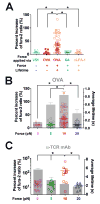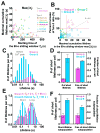Accumulation of dynamic catch bonds between TCR and agonist peptide-MHC triggers T cell signaling
- PMID: 24725404
- PMCID: PMC4123688
- DOI: 10.1016/j.cell.2014.02.053
Accumulation of dynamic catch bonds between TCR and agonist peptide-MHC triggers T cell signaling
Abstract
TCR-pMHC interactions initiate adaptive immune responses, but the mechanism of how such interactions under force induce T cell signaling is unclear. We show that force prolongs lifetimes of single TCR-pMHC bonds for agonists (catch bonds) but shortens those for antagonists (slip bonds). Both magnitude and duration of force are important, as the highest Ca(2+) responses were induced by 10 pN via both pMHC catch bonds whose lifetime peaks at this force and anti-TCR slip bonds whose maximum lifetime occurs at 0 pN. High Ca(2+) levels require early and rapid accumulation of bond lifetimes, whereas short-lived bonds that slow early accumulation of lifetimes correspond to low Ca(2+) responses. Our data support a model in which force on the TCR induces signaling events depending on its magnitude, duration, frequency, and timing, such that agonists form catch bonds that trigger the T cell digitally, whereas antagonists form slip bonds that fail to activate.
Copyright © 2014 Elsevier Inc. All rights reserved.
Figures







References
-
- Alam SM, Travers PJ, Wung JL, Nasholds W, Redpath S, Jameson SC, Gascoigne NRJ. T-cell-receptor affinity and thymocyte positive selection. Nature. 1996;381:616–620. - PubMed
Publication types
MeSH terms
Substances
Grants and funding
LinkOut - more resources
Full Text Sources
Other Literature Sources
Research Materials
Miscellaneous

